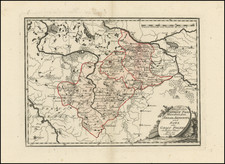The Most Important Plan of Warsaw Published in the 18th Century.
Nice example of this rare and highly important 4-sheet plan of Warsaw by Pierre Ricaud de Tirregaille , first published in 1762. The plan provides a meticulous depiction of the newly updated "modern" city of Warsaw, surrounded by vignettes depicting 18 buildings. The plan names in Polish and French 82 separate buildings, including the Royal Palace, the Archcathedral of St. John, and the Załuski Library (the first public library in Poland).
Below the plan is large panoramic birdseye view of the city from across the Vistula River.
Pierre Ricaud de Tirregaille (1725-1770) was a French Architect and Engineer. Tirregaille came to Poland in 1752, where he worked as a civil architect, surveyor and as an army engineer and captain of an infantry regiment. He attained the rank of lieutenant colonel in the Polish armed forces in 1762.
In 1758 and 1759, Tirregaille worked for the "Komisja Brukowa" or Cobblestone Commission. Created in 1685, the Cobblestone Commission was tasked with paving the streets of Warsaw and creating a modern sewer system. The Commission remained largely inactive until 1740, when it was headed by Crown Marshal Franciszek Bielinski. Under his leadership, over the next 20 years, the commission managed to pave 222 streets, a large majority of streets of the contemporary Polish capital.
In 1757, Bielinski, with his own funds, created a the village of Bielino, which would become the modern city center of Warsaw.
In 1762, with his work nearly completed, Bielinski commissioned Tirregaille to prepare a detailed plan of the city of Warsaw, which resulted in the creation of the first map of Warsaw based upon a scientific survey. The view was embellished with vignettes of important buildings around the city, including, the Primate's Palace, the Symonowicz Palace, the palace of the Bishops of Cracow and the Radziwill Palace. Tirregaille's plan depicts the culmination of Bielinski's efforts.
The Tirregaille plan is dedicated to King Augustus III, King of Poland and Elector of Saxony.
The original Tirregaille plan is known in only 5 recorded examples (British Library (2 copies), National Library of Poland, Bibliotheque Nationale de France and Harvard. The original manuscript was destroyed in 1944, during WWII.









![[Holy Roman Empire] A Newe Mape of Germany Newly Augmented by Iohn Speed Ano Dom: 1626](https://storage.googleapis.com/raremaps/img/small/67323.jpg)
![[ Lviv / Tarnow ] Des Koenigreichs Galizien und Lodomerien mittlere Kreise](https://storage.googleapis.com/raremaps/img/small/103315.jpg)
![[ Poland ] Poloniae Finitimarumque locorum descriptio Auctore Wencelslao Godreccio](https://storage.googleapis.com/raremaps/img/small/67482.jpg)
![[ Poland / Lithuania / Kaliningrad ] Das Konigreich Preussenmit den freien Stadten Danzig u Thorn](https://storage.googleapis.com/raremaps/img/small/102639.jpg)

